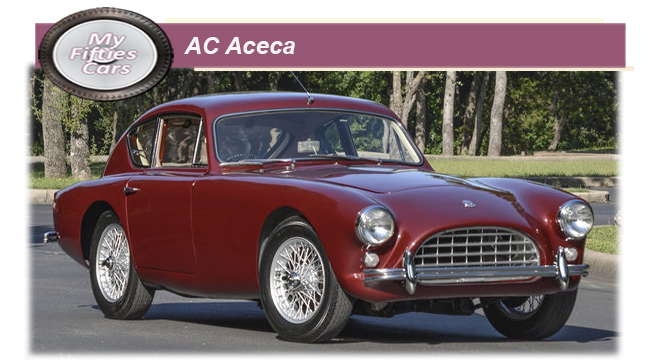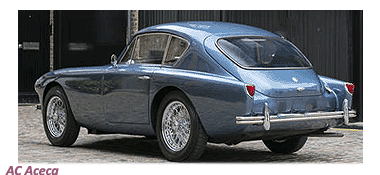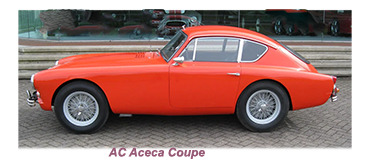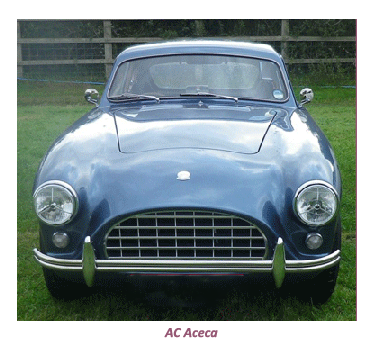
In 1954, riding high on the relative success of their Ace open-top Sportster, AC made what was a sound marketing decision to produce as many “spin-offs” as they reasonably could of their top seller.
This decision led to the launch of two new ACs the Aceca and the Greyhound, with the Aceca proving to be by far the more commercially successful of the two.
 The Aceca got off to the least promising of starts, due to the AC’s failed experiment of fitting the coupe with a simple glass fibre hardtop. All the company succeeded in doing was exaggerating the heat build-up and noise inside the car.
The Aceca got off to the least promising of starts, due to the AC’s failed experiment of fitting the coupe with a simple glass fibre hardtop. All the company succeeded in doing was exaggerating the heat build-up and noise inside the car.
 Caught up in the concept, to their credit, AC embarked upon an extensive re-engineering project that gave birth to the Aceca.
Caught up in the concept, to their credit, AC embarked upon an extensive re-engineering project that gave birth to the Aceca.
 The basic tubular chassis of the Ace was retained for the new model, as was much of the bodywork, while the doors were enlarged and strengthened with ash framing, and a new fastback roof was fashioned out of aluminium and supported by an auxiliary tubular framework.
The basic tubular chassis of the Ace was retained for the new model, as was much of the bodywork, while the doors were enlarged and strengthened with ash framing, and a new fastback roof was fashioned out of aluminium and supported by an auxiliary tubular framework.
![]()
 To reduce the noise levels of the engine as well as the excessive e heat and fumes generated, AC's engineers developed a full-width bulkhead from glass fibre, designed to sit between the engine bay and the cockpit.
To reduce the noise levels of the engine as well as the excessive e heat and fumes generated, AC's engineers developed a full-width bulkhead from glass fibre, designed to sit between the engine bay and the cockpit.

 Towards the end of its production run from 1961 to 1963, a few Acecas were produced powered by a 2553 cc tuned Ford Zephyr engine- this last version of the coupe marketed as the Aceca 2.6.
Towards the end of its production run from 1961 to 1963, a few Acecas were produced powered by a 2553 cc tuned Ford Zephyr engine- this last version of the coupe marketed as the Aceca 2.6.
the Aceca’s design allowed for an almost perfect 50/50 weight distribution, which coupled with its massive 16" spoked road wheels meaning exceptional handling even on dirt roads while providing an impressive top speed of over 128 mph on the track.
![]()
 In line with the concept to produce a luxury hardtop coupe, AC ensured that the Aceca’s interior was fitted with trim that would have been deemed too luxurious for the more spartan Ace, including luxurious Wilton carpet, leather upholstery and wood trimmings as well as excellent ventilation and demister systems.
In line with the concept to produce a luxury hardtop coupe, AC ensured that the Aceca’s interior was fitted with trim that would have been deemed too luxurious for the more spartan Ace, including luxurious Wilton carpet, leather upholstery and wood trimmings as well as excellent ventilation and demister systems.
Bearing strong design scenario to the Ace, one noteworthy feature of the Aceca was its sloping rear hatchback, making for only the second car of the Fifties, the other being 1953 Aston Martin DB2/4, to incorporate this element.
 Despite its development in the Ace mode, the Aceca enjoyed reasona ble commercial success and critical acclaim simply because it was different, offering levels of comfort and driving satisfaction that set the trend for many UK auto manufacturers.
Despite its development in the Ace mode, the Aceca enjoyed reasona ble commercial success and critical acclaim simply because it was different, offering levels of comfort and driving satisfaction that set the trend for many UK auto manufacturers.
Take me back to the home page


